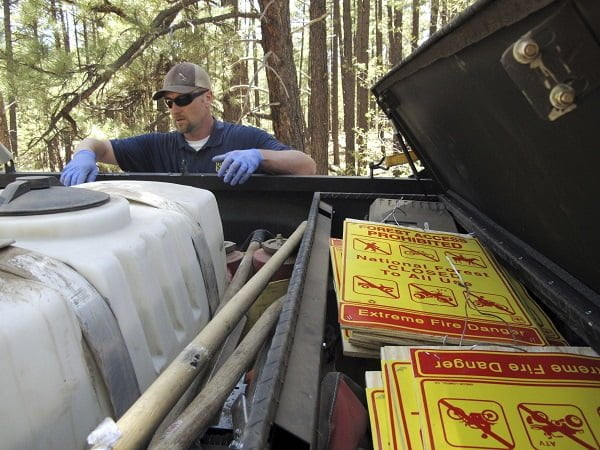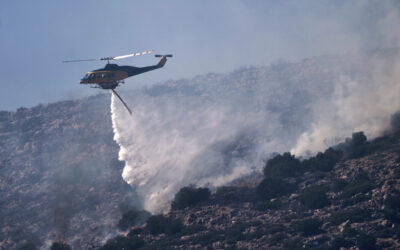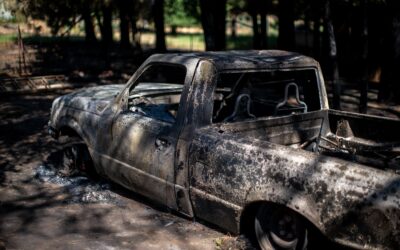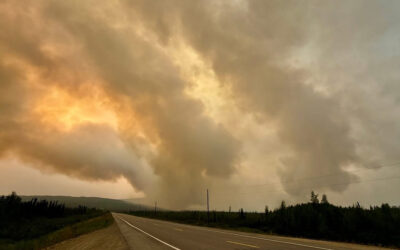Many parts of the West are dealing with drought

In this Thursday, May 24, 2018, photo, Matt Engbring, a fire prevention officer with the U.S. Forest Service, checks on signs that alert the public to closures in parts of the national forest surrounding Flagstaff, Ariz. Many parts of the West are dealing with drought, but nowhere else has more state and federal land been closed to recreation than in Arizona where conditions are ripe for large-scale wildfires. (AP Photo/Felicia Fonseca)
By FELICIA FONSECA, Associated Press
FLAGSTAFF, Ariz. (AP) — Dry pine needles and dead wood snapped under fire prevention officer Matt Engbring’s boots as he hiked a half-mile into the woods in search of a makeshift campsite that had served as one man’s home until this week when the area was closed because of the escalating threat of massive wildfires.
Engbring walked past small ravines where wind quickly could carry embers and by the charred remains of a campfire, finally reaching the spot where John Dobson had been living among ponderosa pines in Arizona’s Coconino National Forest.
He spotted Dobson earlier as he was leaving the forest with his bicycle and issued a warning that he’ll likely repeat over the busy Memorial Day weekend as tourists flock to Arizona’s cooler mountainous areas to hike, bike, camp and fish.
“The area is closed now, and I can’t allow you to go back in,” he said.
Many parts of the West are dealing with drought, but nowhere else has more state and federal land been closed to recreation than in Arizona where conditions are ripe for large-scale wildfires. Portions of the Apache-Sitgreaves, Coconino, Kaibab and Tonto national forests are closed because the dry vegetation quickly can go up in flames, firefighters would have a hard time stopping it, and homes and water resources are at risk.
In neighboring New Mexico, fire restrictions are in place, but no forests have closed. Forest officials in the western part of that state have suspended woodcutting permits, including ceremonial wood gathering by Native American tribes. They’ve also warned the public to look out for hungry bears.
Forests in southern Colorado and southern Utah are open but officials are limiting campfires to developed areas.
“A lot of our rural, small communities depend on recreation and access to public land, so it’s on the table but really an option of last resort,” said Holly Krake, a spokeswoman for the U.S. Forest Service region that includes Colorado.
Weather over the next six weeks is expected to be in line with the typical onset of fire season: increasingly hot, breezy and dry. Then the monsoonal system that carries heavy rain should kick in.
“The bottom line is it’s going to get worse before it gets better,” said Rich Naden, fire weather meteorologist with the Southwest Coordination Center. “But this time of year is always like that. It’s almost like clockwork.”
Widespread forest closures in Arizona are rare. The 1.8 million-acre Coconino National Forest shut down completely because of fire danger in 2006 for nine days. A 2002 shutdown lasted nine weeks, encompassing the Memorial Day and July 4 holidays. Other national forests had closures in 2002 as well.
The current closures are affecting a small percentage of national forests in Arizona, and the general guidance for tourists is to check ahead of time to see what’s open and whether campfires are allowed.
In Flagstaff, Los Angeles residents Pauline and John Barba had hoped to barbeque this week while staying at a commercial campground, but charcoal grills were wrapped in yellow caution tape.
Nearby, a bright yellow sign on the barbed wire fence warned that no one is allowed in the forest.
“We love the outdoors and the pine trees and everything,” she said. “It’s just a shame people are destructive and not careful.”
Beyond inconveniencing campers and hikers, the drought’s effects and forest closures are being felt by ranchers who can’t graze cattle in the forest and researchers who can’t conduct studies. Forest thinning projects also are delayed.
At a ski resort outside of Flagstaff, 50 people are out of work, and hundreds of tickets for pre-booked activities have been canceled. The Arizona Snowbowl, which operates under a special permit in a closed forest area, had hoped to run its scenic chair lift and debut family activities this weekend.
Those who left camping trailers in now-closed areas of the Coconino National Forest to stake out a spot for the busy holiday weekend will have to call forest officials to unlock the gate to let them out. Others have tried avoiding officials patrolling the forest or sneaking in when no one is looking.
The biggest fear is that a campfire sparks a wildfire. The Coconino National Forest recorded 700 abandoned campfires last year, and 121 built illegally during fire restrictions, setting a record. Target shooting, drones, cigarettes and sparks from vehicle exhausts also are concerns.
At his campsite, Dobson said he used a butane stove to cook rather than light campfires. He heard about the closure a few days earlier at a local food bank, saying he was in a tough spot with nowhere to take his dishes, books and clothing.
Engbring called for help from his colleagues to haul Dobson’s belongings out of the forest. After loading up Dobson’s bike in the back of a pickup truck, they headed for the food bank.
___
Associated Press writer Susan Montoya Bryan in Albuquerque, New Mexico, contributed to this report.
All contents © copyright 2018 Associated Press. All rights reserved.




